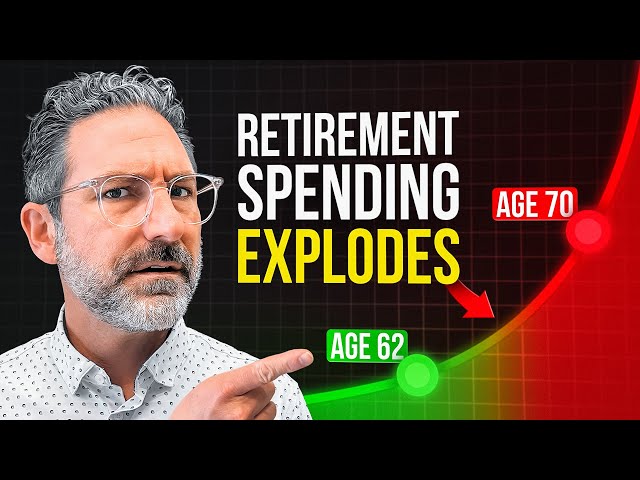Age 65 marks a major financial turning point for many retirees, and it’s not just because Medicare kicks in. It’s the beginning of a new lifestyle, new habits, and for most households, a noticeable spike in spending.
We’ve helped guide retirees through every phase of their journey, so we’ve seen how spending patterns in retirement can surprise people. Sometimes it’s to their benefit, but sometimes it’s not!
Let’s explore why spending often increases dramatically around age 65, the three phases of retirement spending, and how build a retirement that supports your lifestyle from start to finish
Retirement Isn’t Linear, So Your Spending Shouldn’t Be Either
Many people assume that once they retire, they’ll spend a steady amount each year, adjusting only for inflation. But real life doesn’t work that way.
Retirement spending tends to follow a curve, not a straight line. We call it the “retirement spending smile.” Here’s how it breaks down:
The Go-Go Years (Early Retirement):
These are your most active years, typically your late 50s through your early 70s. Every day is Saturday. You travel, remodel, pick up new hobbies, and check off bucket list items. Your spending will spike as you fill your time with long-postponed dreams and indulgences.
The Slow-Go Years (Mid Retirement):
You begin to settle into a rhythm. You may still travel or pursue hobbies, but perhaps at a slower pace or with more selectivity. Life becomes more routine, so your spending slows down.
The No-Go Years (Late Retirement):
Health begins to play a bigger role in your decision-making. Travel and high-energy activities decline. Medical and custodial costs rise. Spending on fun decreases, but essential healthcare costs may rise.
This shift isn’t just theoretical — it’s backed by data. According to the U.S. Bureau of Labor Statistics, households age 65–74 spend 40% of their budget on discretionary items. By 75+, that figure drops to 32% as essentials (like healthcare) take a bigger bite.
Why Age 65 Is a Spending Crossroads
Spending often jumps specifically at age 65 as a function of how people retire. At that age, people are:
-Finally free from work, which opens the door to long-deferred hobbies, home upgrades, and big travel.
-Adjusting to Medicare, which may reduce some healthcare costs but doesn’t cover everything.
-Still healthy and mobile, which encourages a flurry of activity (and associated costs).
Inflation plays a role in pushing many baseline living costs higher as well. From 2012 to 2022, average food spending rose from $5,000 to $7,300/year and transportation costs jumped from $6,300 to $8,200/year
Even though housing is often considered a fixed cost, it matters as well. While many retirees aim to pay off their mortgage, some go the other direction and upsize into a “dream home,” only to find themselves house-poor later on.
The lesson here is as follows: choices made in your 60s ripple through the rest of your retirement.
The Right Way to Budget for Retirement
Some people use a “replacement ratio,” which is a quick shortcut that estimates that you’ll need somewhere between 55% and 80% of your pre-retirement income, depending on how much you earn today. It’s simple, but it doesn’t reflect what you actually spend.
That’s why we prefer a more thoughtful, detailed approach. Here’s how to do it!
Start by creating a simple spreadsheet with two columns: what you spend now, and what you expect to spend in retirement. Walk through each category — housing, groceries, travel, insurance — and talk it through with your spouse or partner. Be sure to include irregular costs like gifts or big one-time purchases. Then ask yourself: which expenses will go away, and what major costs might come up in those early years? A house remodel or new vehicle? Building these expenses into your plan early helps avoid surprises and gives you freedom to enjoy the years ahead without stress.
And don’t forget the final phase of retirement — the so-called “no-go” years. Most people avoid thinking about it, but it’s important. Medicare doesn’t cover custodial care, and long-term support can be expensive. Planning ahead now puts you in control later, when flexibility matters most.
Retirement spending changes over time, and your plan should too. Enjoy the active years, prepare for the slower ones, and protect yourself from the unknowns that come later. The best strategies aren’t static — they evolve with you.
If you want calmness and clarity in retirement, we’re here to help. Click here to book a no-cost consultation with the Brindle & Bay team, and let’s build a plan that gives you confidence in every phase of life.
The client stories shared in this blog post are intended for illustrative purposes only. While inspired by real-life experiences, these examples are composites drawn from a range of client situations and do not represent any one individual. They may be considered indirect testimonials. Actual client experiences will vary. No clients were compensated for sharing their stories.






.jpg)





